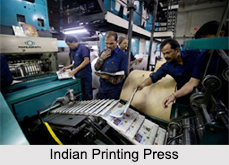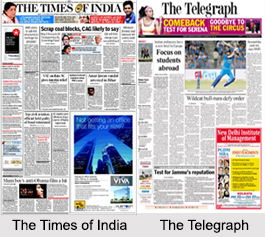 Indian press is said to be the largest section of print media in the globe. Indian printing houses publish more daily newspapers than any other country in Asia, covering a range of languages and educational topics that is unmatched in the world. According to a survey in 2000, there were over 27,000 newspapers and periodicals in India that were published in 93 languages. Some 5,000 dailies were read by more than 100 million readers in 14 languages. However, in a nation with a high rate of illiteracy, the effects of these newspapers and periodicals in those days were limited to an elite audience.
Indian press is said to be the largest section of print media in the globe. Indian printing houses publish more daily newspapers than any other country in Asia, covering a range of languages and educational topics that is unmatched in the world. According to a survey in 2000, there were over 27,000 newspapers and periodicals in India that were published in 93 languages. Some 5,000 dailies were read by more than 100 million readers in 14 languages. However, in a nation with a high rate of illiteracy, the effects of these newspapers and periodicals in those days were limited to an elite audience.
Historical Development of Indian Press
History of Indian press dates back to 1780, with the publication of the first Indian newspaper namely, Bengal Gazette or Calcutta General Advertise from Calcutta by James Augustus Hickey. Hickey is therefore known as the "father of Indian press". In 1789, the first newspaper from Bombay namely, Bombay Herald started. It was followed by the Bombay Courier in the next year. Similarly, newspapers started flourishing in various parts of India in regional languages. The first newspaper in an Indian language was the Samachar Darpan. This newspaper was published in Bengali. Eenadu was a Telugu daily, which was started by Ramoji Rao.
Later, increase in literacy rate started having a direct positive effect on the rise in circulation of regional newspapers. The people were primarily receiving education in their mother tongue. Thus, the regional newspapers gained immense popularity in this period. Indian press circulated regional newspapers in several editions for a particular state. The regional newspapers aimed at providing localized news for their readers. Even advertisers could see the huge potential of the regional newspaper market.
 In 1966, Indian Press was strengthened by the formation of the Press Council of India. This council was established by the Parliament to preserve the freedom of press and to maintain and improve the standards of press in India, on the recommendations of the First Press Commission.
In 1966, Indian Press was strengthened by the formation of the Press Council of India. This council was established by the Parliament to preserve the freedom of press and to maintain and improve the standards of press in India, on the recommendations of the First Press Commission.
During the late 1970s, a magazine boom occurred in India. Newly founded news magazines like India Today capitalized on Indian readers` unfulfilled requirements for news and other information, during the emergency years from 1975 to 1977. It was the time when freedom of press was revoked. The prosperity of Indian press took place because of improvements in printing technology and the sale of commercial advertising, especially color advertisements, which greatly made the magazines appealing. Detailed and investigative news coverage by magazines also made it an attractive alternative to most newspapers.
In the late 1980s and the 1990s, Indian newspapers underwent a facelift in order to move parallel with magazines. At the time, television also started acting as a major contestant for advertising revenues. Insensitive political coverage had scaled down and colorful features on lifestyles, business and entertainment were added. During the 1990s, many publishing groups like Living Media Private Limited (publishers of India Today), Time and Newsweek in the U.S. and Bennett, Coleman & Co. Ltd (publishers of The Times of India) moved into the production of television programs and launched internet portals, thus, gaining a wider audience as compared to the print media.
Indian Press at Present
Indian press is playing a major role in contemporary India. It is helping in creating awareness about serious issues affecting the development of nation and links people belonging to different parts of India. Starting from the delivery of news and display of advertisement, newspapers play a vital role in the everyday life of Indians. Several media houses and private newspaper agencies have come up in India. Indian newspapers are owned mainly by individuals or private firms. Therefore, Indian press is relatively free from government control. The major national dailies like The Statesman, The Telegraph, The Times of India, The Asian Age, The Economic Times and others are read all over the country, while the regional newspapers have found profound audience in their respective regions. There are organizations in India, which gather news items and distribute them to newspapers or broadcasters. These organizations are called news agencies. India has several news agencies like the Press Trust of India, Hindustan Samachar and Samachar Bharti.




















